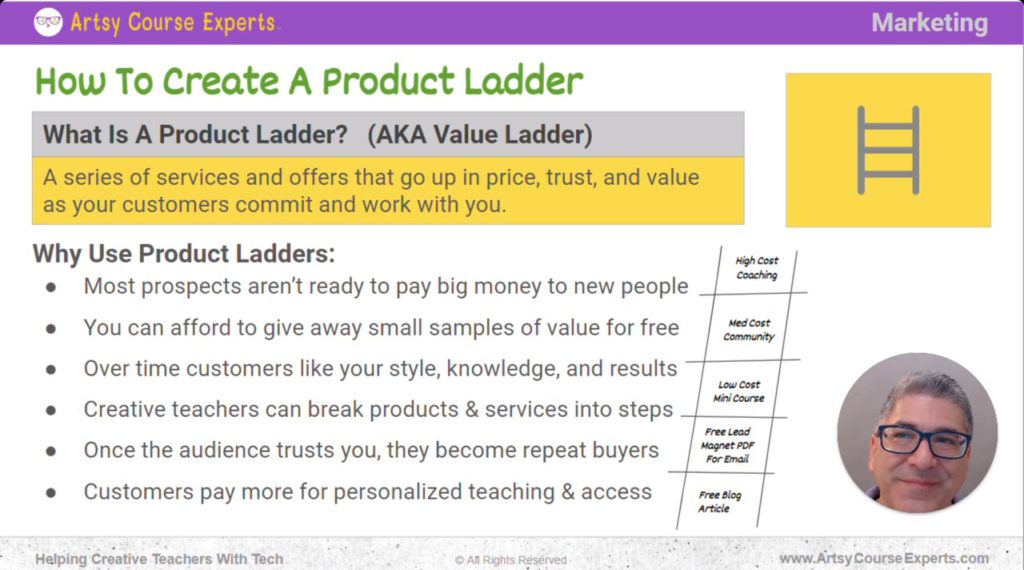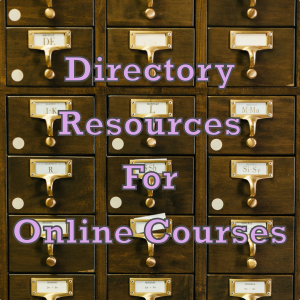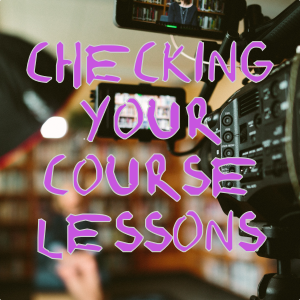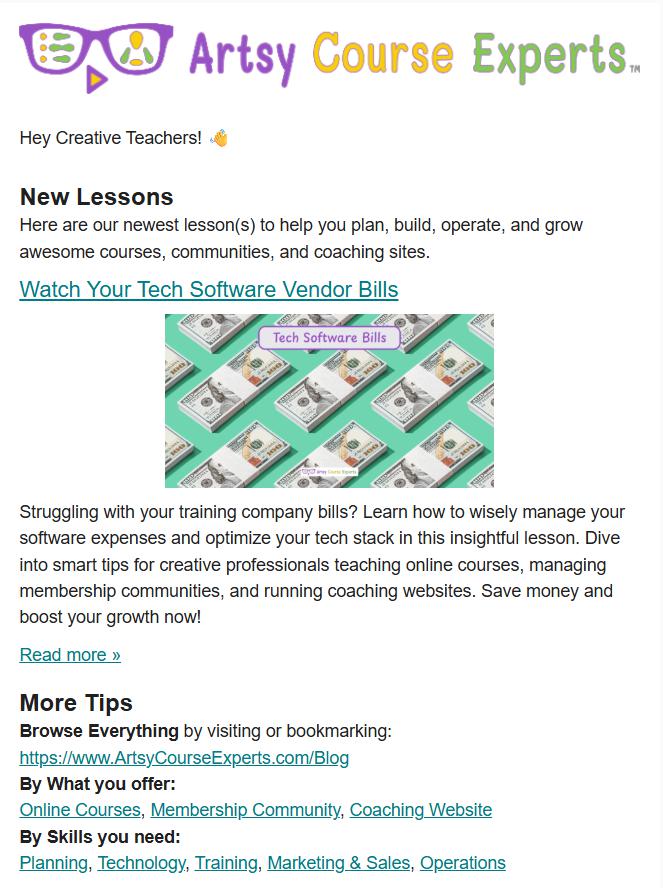Introduction
A product ladder is a marketing strategy that involves offering an increasing range of products to cater a variety of customers. It allows you to start with lower-end offerings and later upsell higher-end services to those seeking more.
In this lesson, we’ll explore how to craft a product ladder for your training business. This approach empowers you to sell a wider range of products and services, capitalizing on the concept of offering value steps with prices ranging from low to high.
Challenges online teachers can face if they don’t utilize product ladders could include:
- Less new customer sales that can’t afford your products and services.
- Missed opportunities to upsell to existing customers.
- Inability to cater to varying customer budgets.
- Reduced long-term value and earnings from repeated buyers.
- Lower total revenues by focusing on one product or price tier.
Video Lesson – Taking Customers from Lower Offerings to Higher Products and Services
What is a Product Ladder?
Product ladders, sometimes called value ladders, are a series of products or services that go up in price, trust, and value as your customers commit to and work with you. At a very high level, you start by selling a lower-cost item. Once customers have experienced its value, developed trust, and formed a favorable opinion of your brand, you can proceed to sell them subsequent products.
Essentially, a product ladder involves progressively offering larger and more expensive products and services over time. Without implementing a product ladder, you might encounter difficulties making sales if you only sell a highly-priced item. Prospective customers may lack the opportunity to test your products and services, either because they don’t trust your skills yet and/or the price is too high.
Alternatively, if you significantly reduce your prices, you may attract some customers, but it also means sacrificing potential revenue. The product ladder allows you to sell at multiple prices at the same time. Most customers will probably start with inexpensive products and gradually move towards higher-priced offerings.

Why Use Product Ladders?
Most Prospects Don’t Pay A Premium To New Providers
Initially, most prospects are unwilling to make substantial payments for services. They are hesitant to shell out a significant amount of money. Therefore, a product ladder allows you to offer a lower-end product or service to individuals who have discovered you.
These individuals may have been impressed by their initial encounter with your brand or by your sales page. A product ladder is ideal for those who have recently come across your offerings and wish to give them a try for free or low cost. However, they are not yet prepared to commit to higher prices.
You Can Afford to Give Away Small Samples of Value for Free
As an authoritative and creative teacher, you can offer small samples of value free of charge. These samples could take the form of a blog, YouTube video, podcast, template, resource file, or checklist. You will probably be able to provide your audience with an impressive sample that demonstrates your expertise and knowledge.
Invite your audience to try out your content and learn some creative tips and skills. As a course creator, community leader, or coach, you can easily create valuable content that can be offered for free. Subsequently, you can progress towards creating products and selling a series of more expensive offerings.
Over Time Customers Will Like Your Style
Over time, your customers will develop a liking for your style, appreciate your knowledge, and benefit from your content. At that stage, you can encourage customers to progress up the ladder, transitioning from free services to initial low-cost products and services.
Some of the personal factors that students like include:
- Your language and accent
- Your teaching style
- Your sense of humor
- Your examples
- Your studio, set, or environment
Creative Teachers Can Break Content Into Steps
Instead of offering one massive course, consider dividing it into multiple components. This could include an ebook, a mini-course, and subsequent pieces that gradually increase in value. It is important to strategize how to segment your skills and services into a series of steps, starting from the lowest cost and value, and progressing upwards.
This approach ensures that you avoid having a single overly expensive product that alienates potential customers. You also don’t want to cater to the small group who are willing and able to pay more for the full comprehensive solution like 1:1 coaching. By using steps, you can effectively sell solutions to small problems all the way to big problems.
Once the Audience Trusts You, They Become Repeat Buyers
It is important to remember that you are aiming to build trust. To do this, we recommend that you initially focus on offering lower-end products and services. By delivering some value, your audience will get to know you better and engage with you more frequently.
Over time, your audience will begin to trust you. As this trust develops, they will recognize that you provide valuable content and are skilled to assist them on their journey. This trust will lead to them becoming repeat buyers. Once they experience the positive impact of a small purchase and find it perfect for their needs, they will likely be inclined to move up to the next level.
As a result, you will have a customer base consisting of repeat buyers who progress from lower-priced items to higher ones. Additionally, you may have customers who generate lifetime value by subscribing to a membership or monthly coaching program.
Customers Pay More for Personalized Teaching & Access
Remember, customers are willing to pay a higher price for personalized teaching and direct access to you as the expert. Once they have learned about you and developed a liking for you, their desire for more will grow. Eventually, they may seek direct access to you to ask specific questions tailored to their unique situations.
While your products and services may be designed for groups of students, they may not address each individual’s exact circumstances. Therefore, certain students and customers who desire specific answers and wish to share their unique situations with you, seeking your feedback and advice to progress further, are willing to pay a premium.
By guiding them up the product ladder, you have already established trust and demonstrated your skills. These customers may seek precise answers directly from you, and they are willing to invest more to receive personalized responses and gain access to your expertise.
Finally, some customers may be well off financially or have a big/timely initial problem and decide to skip your lower product ladder steps and jump right to step 3 or 4 like an expensive master class or group coaching.
Who Can Use a Product Ladder?
- Graphic designers can leverage a product ladder to offer entry-level design templates, intermediate skill-building courses, and advanced setting up a design agency.
- Writers can use a product ladder to provide aspiring writers with basic writing guides, advanced storytelling workshops, and personalized manuscript editing services.
- Artists can create a product ladder encompassing beginner art tutorials, intermediate painting workshops, and exclusive art mentorship programs.
- Musicians can develop a product ladder featuring introductory instrument courses, masterclass playing today’s popular music, and one-on-one tutoring.
- Photographers can implement a product ladder comprising beginner photography workshops, advanced editing tutorials, and exclusive destination photography expeditions.

Example: Product Ladder for Creative Teachers
Article on Blog
When considering your offerings, there are two key factors to consider: accessibility and value. For instance, providing something for free could be as simple as a customer reading an article on your blog.
If your students find it helpful and it resonates with them, they may develop an interest in learning more about you and your expertise. In some cases, they may even choose to subscribe to your blog providing their email address, allowing them to receive a helpful PDF magnet. As you then email them content like new blog posts, they engage with your material and ultimately become eager to learn more from you.
Mini Course
As customers progress up the product ladder, you can offer them a low-cost mini-course. This mini-course can teach a creative class an introduction or primer, rather than an extensive and comprehensive program like an expensive masterclass.
It provides meaningful value at an affordable price point and helps your students without requiring a significant commitment. Following completion of the mini-course, which can be a few weeks or months later (not necessarily immediately), they may want more content and help from you.
Pro Community
As a creative online course teacher, one of the next offerings could be a community for your customers. This option may be priced slightly higher than the low-cost mini course. The community is also another level of commitment, because it may contain a subscription angle.
By joining the community, customers gain access to a wealth of value that surpasses what they obtained from the free article and the mini course. And of course, these students paid a premium for this.
1:1 Coaching
One-on-one coaching sessions are priced higher compared to the mini-course, community, monthly, or annual membership.
However, these sessions offer students direct access to you, enabling them to ask personalized questions, provide context, and tap into your expertise. It’s extremely valuable to students to get their exact questions answered by you.
Students can have confidence that the advice you provide will propel them forward in their journey. It’s important to note that coaching is not offered to everyone at lower prices; it is exclusive to a select group of customers. Moreover, it is crucial to manage your time effectively, as coaching cannot be scaled to accommodate a large number of individuals. Although group coaching may be another step you offer before 1:1 coaching.
For the customers seeking coaching, it comes at a premium price, but the value they receive is substantial. By diversifying your products and services, you make them accessible to a broad range of customers, including those who have recently discovered you and those who are convinced that you can guide them in their next steps.
Frequently Asked Questions About Marketing Product Ladders

Summary – How to Create a Product Ladder
Creating a product ladder is a powerful strategy for online course creators, community leaders, and coaches. It allows you to offer products and services at various price points including affordable entry-level options, a moderate range in the middle, and premium high-priced levels.
Most customers need time and samples before they shell out big money to new experts. So for these customers, you need to include free content and lower-priced starter pricing.
On the flip side, for some customers price may not be a concern, especially when they have a pressing issue or a high-priority problem that requires access to your expertise. So those folks will just get whatever they need.
Additionally, you can capitalize on lifetime value by cultivating repeat buyers as they progress through the product ladder or become part of your community. So, start implementing a product ladder to grow your creative business sales.
Tips for how to use product ladders for creative business owners:
- Break down your offers, products, and services into different steps on a product ladder
- To build trust, you should begin with something free
- Utilize an entry-level price for something small but more valuable than free content
- Offer a moderately priced option for customers after they buy the lower-level products
- Always offer some high-end product or service for periodic customers that aren’t price sensitive
- Connect each step in your product ladder so that you create pathways to higher-end services
You should be a little smarter now. Thanks for hanging out!
Please subscribe to get more tips for creative online course teachers.
More Tips For Online Teachers
These lessons can also help you with Sales and Technology:
- Learning about Monthly Recurring Revenue for Online Course Creators
- Analytics for Teacher Websites
- Understanding Your Ideal Target Audience For Online Course Teachers
- Offering Course Payment Plan Options
- Planning New Online Courses Using SWOT Analysis











